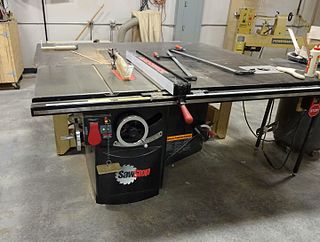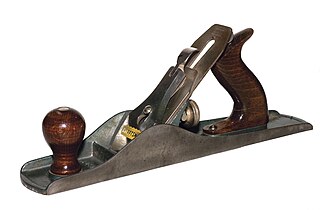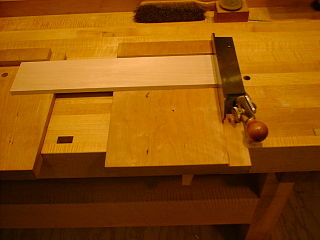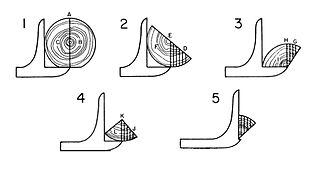
The router is a power tool with a flat base and a rotating blade extending past the base. The spindle may be driven by an electric motor or by a pneumatic motor. It routs an area in hard material, such as wood or plastic. Routers are used most often in woodworking, especially cabinetry. They may be handheld or affixed to router tables. Some woodworkers consider the router one of the most versatile power tools.

A chisel is a wedged hand tool with a characteristically shaped cutting edge on the end of its blade, for carving or cutting a hard material. The tool can be used by hand, struck with a mallet, or applied with mechanical power. The handle and blade of some types of chisel are made of metal or wood with a sharp edge in it.
A saw is a tool consisting of a tough blade, wire, or chain with a hard toothed edge used to cut through material. Various terms are used to describe toothed and abrasive saws.

A table saw is a woodworking tool, consisting of a circular saw blade, mounted on an arbor, that is driven by an electric motor. The drive mechanism is mounted below a table that provides support for the material, usually wood, being cut, with the blade protruding up through the table into the material.

A hand plane is a tool for shaping wood using muscle power to force the cutting blade over the wood surface. Some rotary power planers are motorized power tools used for the same types of larger tasks, but are unsuitable for fine-scale planing, where a miniature hand plane is used.

A Japanese kitchen knife is a type of kitchen knife used for food preparation. These knives come in many different varieties and are often made using traditional Japanese blacksmithing techniques. They can be made from stainless steel, or hagane, which is the same kind of steel used to make Japanese swords. Most knives are referred to as hōchō or the variation -bōchō in compound words but can have other names including -kiri. There are four general categories used to distinguish the Japanese knife designs: handle ; blade grind ; steel ; and construction.

A file is a tool used to remove fine amounts of material from a workpiece. It is common in woodworking, metalworking, and other similar trade and hobby tasks. Most are hand tools, made of a case hardened steel bar of rectangular, square, triangular, or round cross-section, with one or more surfaces cut with sharp, generally parallel teeth. A narrow, pointed tang is common at one end, to which a handle may be fitted.

A biscuit joiner or biscuit jointer is a woodworking tool used to join two pieces of wood together. A biscuit joiner uses a small circular saw blade to cut a crescent-shaped hole in the opposite edges of two pieces of wood or wood composite panels. An oval-shaped, highly dried and compressed wooden biscuit is covered with glue, or glue is applied in the slot. The biscuit is immediately placed in the slot, and the two boards are clamped together. The wet glue expands the biscuit, further improving the bond.

A miter saw or mitre saw is a saw used to make accurate crosscuts and miters in a workpiece by positioning a mounted blade onto a board. A miter saw in its earliest form was composed of a back saw in a miter box, but in modern implementation consists of a powered circular saw that can be positioned at a variety of angles and lowered onto a board positioned against a backstop called the fence.

A kitchen knife is any knife that is intended to be used in food preparation. While much of this work can be accomplished with a few general-purpose knives — notably a large chef's knife and a smaller serrated blade utility knife — there are also many specialized knives that are designed for specific tasks such as a tough cleaver, a small paring knife, and a bread knife. Kitchen knives can be made from several different materials, though the commonest is a hardened steel blade with a wooden handle.

A wood shaper, is a stationary woodworking machine in which a vertically oriented spindle drives one or more stacked cutter heads to mill profiles on wood stock.

Japanese carpentry was developed more than a millennium ago that is known for its ability to create everything from temples to houses to tea houses to furniture by wood with the use of few nails.

A thickness planer is a woodworking machine to trim boards to a consistent thickness throughout their length. This machine transcribes the desired thickness using the downside as a reference / index. So, to produce a completely straight planed board requires that the down surface is straight before planing. Obtaining the first flat side requires either face planing with a jointer or face planing using a planer and jointer sled.

A shooting board or shootboard is a jig for woodworking which is used in combination with a hand plane to trim and square up the edges and ends of boards. It is typically used on a workbench. A plank or board with edges planed flat is called a shot edge board.

A butt joint is a wood joint in which the end of a piece of material is simply placed against another piece. The butt joint is the simplest joint. An unreinforced butt joint is also the weakest joint, as it provides a limited surface area for gluing and lacks any mechanical interlocking to resist external forces.

Quarter sawing or quartersawing is a woodworking process that produces quarter-sawn or quarter-cut boards in the rip cutting of logs into lumber. The resulting lumber can also be called radially-sawn or simply quartered. There is widespread confusion between the terms rift sawn and quarter sawn with the terms defined both with opposite meanings and as synonyms.
This glossary of woodworking lists a number of specialized terms and concepts used in woodworking, carpentry, and related disciplines.

A riving knife is a safety device installed on a table saw, circular saw, or radial arm saw used for woodworking. Attached to the saw's arbor, it is fixed relative to the blade and moves with it as blade depth is adjusted.

Snipe, in woodworking, is a noticeably deeper cut on the leading and/or trailing end of a board after having passed through a thickness planer or jointer. The term has its origin in forestry where it is applied to a sloping surface or bevel cut on the fore end of a log to ease dragging. (OED)
The splitting band knife is a kind of knife used in several fields including: tannery, EVA/rubber, foam, cork, shoe and leather goods, paper, carpet and other soft sheet materials. It is a power tool which is very similar in operation to a band saw, with an endless loop blade; the material to be cut is supported by a flat table.





















